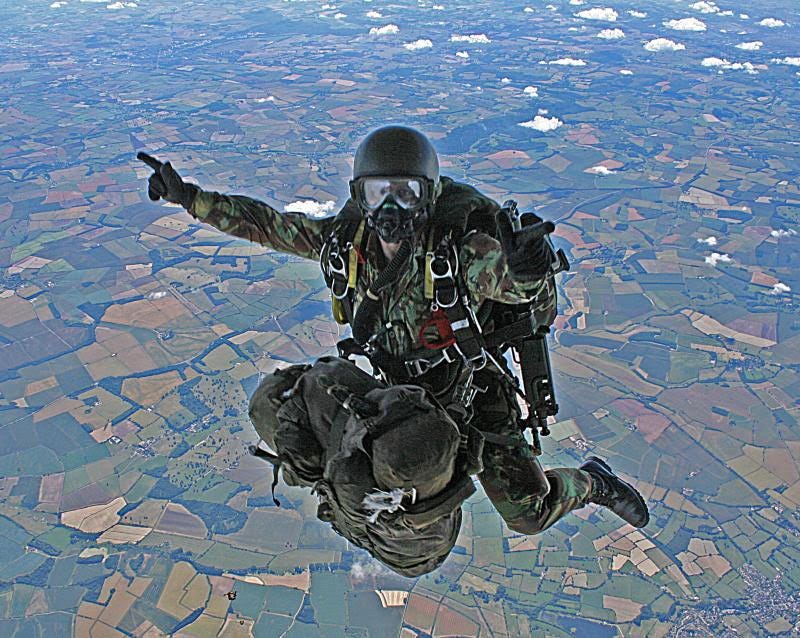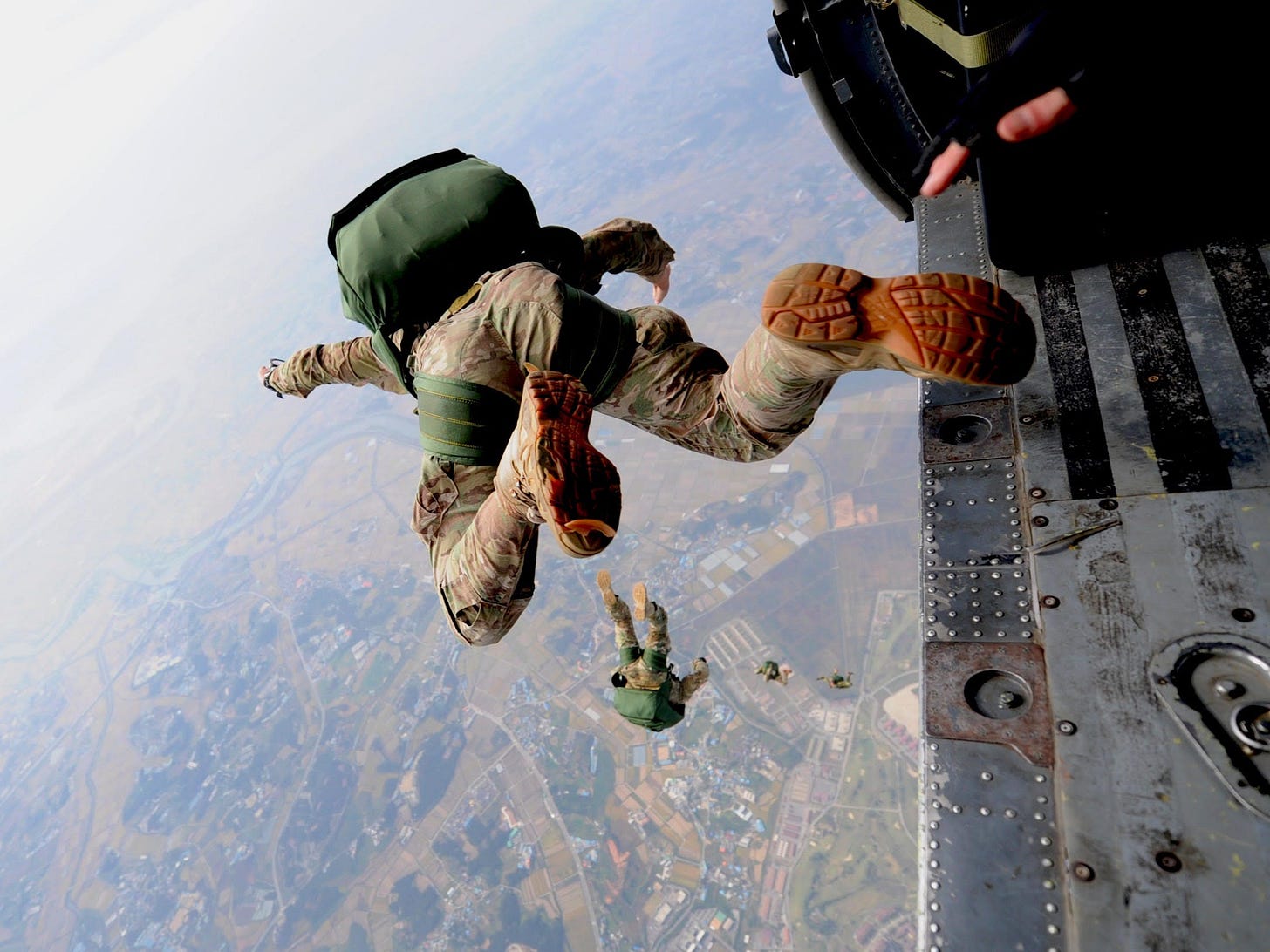Dec- Get in the Wind Cone
Or-You've got the rest of your life to figure it out.

One of the most challenging missions we trained for in Force Recon was HAHO or High Altitude High Opening Parachute insertion.
Jumping from an elevation of 30,000 feet allowed the aircraft to fly along normal commercial air routes, and by opening the parachute almost immediately after exit, we were able to travel over 40 miles under canopy. This meant we could cross international borders and land in a country we weren’t supposed to be in without anyone knowing about it.
HAHO is a tough mission. There is a lot of potential for things to go wrong. The winds at 30,000 feet are often over 150 miles per hour, there’s not enough oxygen to keep you conscious, and it’s cold. If it is 60 degrees on the ground, it’s -50 aloft. Because of this, we wore insulated clothing, face shields, and oxygen masks. Our main and reserve parachutes were on our backs and our rucks, weapons, and equipment were strapped to us.
After opening your parachute and making sure it’s working properly, the next order of business is to turn to the azimuth of the drop zone, locate the rest of your team, and fly toward the target.
It is critical to quickly get into what we call the ‘wind cone’.
The wind cone is an imaginary cone with the pointy end terminating at the Drop Zone (DZ). The factors delineating the cone are distance, speed, and time (expressed as altitude).
If you are in the wind cone you have the elevation at a given speed and distance to reach the DZ.
If you get too far outside of the cone, it becomes hard to make the DZ, and the longer you stay outside of the cone the less your likelihood of success.
If you don’t stay on track, you will fall out of the wind cone and although you might be able to get back on azimuth, you will never reach the DZ. This means at best, you have a long night of walking, and at worst, you may not be able to accomplish your mission.
I tell you this partially because with my book now available for preorder, (I know this is a terrible tie-in, but get used to it.) I have been reminiscing about the good old days, but also because this concept of the wind cone ties in nicely with the ideas we have been talking about.
The first step in planning a HAHO mission is to determine the DZ. Just like our first step is to decide our strategic vision.
In a HAHO operation, the Jumpmaster uses the DZ location to plan backward to determine the HARP - High Altitude Release Point.
Similarly, once we know where we are going, we can draw a back azimuth to our current location.
If you began making the strategic vision list I recommended a few weeks ago, you probably have a good idea of your strategic vision.
These are the things that you want your life to be about.
The things you want to be known for.
The things you would do if you didn’t have to do anything.
Defining your strategic vision can take a while. I tell my coaching clients to carry their list with them on a 3x5 card and review it regularly making adjustments and refinements as needed. Mine took a year to refine, and I can’t say that it won’t change a little in the future, but we can’t let that stop us from making progress.
Don’t let perfect be the enemy of good enough.
Jump out of the airplane and start heading towards the DZ. You might decide that you need to make course corrections as you go, but at least you’re in the wind cone and headed in the right direction.
There is a quote I love from Mark Manson in his book The Subtle Art of Not Giving a F*ck that says:
“Growth is an endlessly iterative process. When we learn something new, we don’t go from wrong to right. Rather we go from wrong to slightly less wrong. And when we learn something additional, we go slightly less wrong to slightly less wrong than that, and then to even less wrong than that and so on.”
Likewise, we will probably update and refine our strategic vision over time, but establishing it (even if it is less than perfect) will give you an azimuth to steer your parachute toward.
While on azimuth to the DZ, we should have a series of observable checkpoints or operational objectives to confirm that we are still in the wind cone.
There are three primary reasons that 85 percent of New Year’s resolutions fail.
#1 They are not aligned to a greater purpose or strategic vision.
When we can see the path from where we are to where we are going, we are better able to overcome the obstacles along the way.
#2 The focus is on the problem instead of the solution— focusing on the thing you are unhappy about instead of doing the thing that will make you happy.
It’s the difference between lamenting all of the reasons that you are out of shape rather than focusing on doing the things that an in-shape person does.
#3 Lack of self-efficacy. Self-efficacy is the belief that you can be successful at a particular task.
It’s extra hard to reach a goal when you don’t believe you can. The remedy for this is to break our desired actions into what Dr. B.J. Fogg calls tiny habits.
What’s the smallest behavior you can reliably and repeatedly execute?
Find it and do it — now.
If you won’t turn toward the DZ now, when do you plan to?
As
said:"The way to live a full life is to act quickly.
Particularly as you grow older, it's alarmingly easy to let a year or two (or five) slip by without doing the big things you always felt like doing. You get into a rhythm—not necessarily one you love, but one you become comfortable repeating—and the grooves of your daily routine become deeper and more established.
Speed is perpetually undervalued. That doesn't mean you should feel frantic or rushed. In fact, it's likely you should eliminate some of the things that make you feel so busy to make space for things you always wanted to do. But it definitely means you should stop letting the days drift by waiting for the moment to be right.
Stop acting like there is infinite time. This—the way you are living right now—is your one life."
Or, as my instructors at Military Freefall school were fond of saying when discussing the procedures for dealing with a parachute malfunction while plummeting towards the earth at terminal velocity (120 MPH):
You have the rest of your life to figure it out.
In our case, altitude equals time. The sooner you start the farther you’ll get.
The time to jump is when the green light is on. If you’re waiting for the New Year to get started on a new or even slightly improved you, we’re approaching the HARP,
Go, Go, Go!
Starting next month, Walking Point will be (partially) behind a paywall.
I’m basing these posts on the program I designed for my performance coaching clients.
While I am not able to take on any new coaching clients right now, I believe these monthly posts will provide a lot of value, and subscribers will be the first to be notified when spots open up.









Well done, John. Deciding and then initiating movement without paralysis are often difficult concepts for folks to internalize.
Sometimes I’ll find myself talking about getting in the wind cone to someone, and I realize what a specific, industry jargon concept it is. Good explanation!